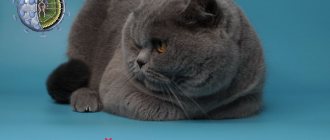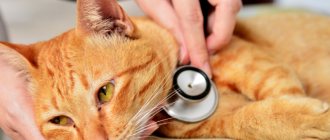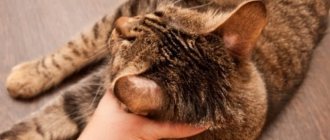The cucumber tapeworm is so named because the mature segments of this parasite are shaped like cucumber seeds (this is clearly visible in the photo and video).
The helminths of this species, which cause dipylidiosis, belong to tapeworms and have the scientific name Dipylidiidae Hymenolepidata. The width of the tapeworm is only 2.5-3 mm, but the length can reach up to 1.5 m. The color is grayish-white or with a pinkish tint.
What to do in such a situation? To get started, we recommend reading this article. This article describes in detail methods of controlling parasites. We also recommend that you consult a specialist. Read the article >>>
Life cycle
The cucumber tapeworm in cats and dogs goes through several stages of development, and it begins with the flea larva or lice eater swallowing the parasite's egg or a mature segment containing its eggs, which have a diameter of 0.03 mm.
The eggs of the parasite are contained in organic waste on which fleas and lice eaters feed; they become the temporary hosts of this parasite, from which this helminth ultimately reaches the main host - cats and dogs, especially often strays.
However, the eggs of the cucumber tapeworm, while remaining in the body of the flea and lice eater larvae, do not develop until the larva moves into a cocoon.
The temporary host grows and, together with the parasite, enters the gastrointestinal tract of the animal or person who swallowed such a flea.
Here, the migration of tapeworm larvae into the small intestine occurs, in which they turn into adult, sexually mature worms by the second month of life.
Individual segments - proglottids containing eggs - are released into the external environment along with the host's feces, and the cycle begins anew.
Possible complications
Prolonged stay of helminths in the intestines of an animal has a detrimental effect on the entire body. There is a high probability of developing complications, since intoxication increases every day, the protective functions of the pet’s immune system decrease, and exhaustion progresses. This leads to malfunctions of all systems. Because of these factors, it is much more difficult for a cat’s body to resist infections. In general, the pet begins to feel much worse.
If treatment is not started on time, then, in addition to the main therapy, veterinarians need to pay attention to inflammation:
- Gallbladder.
- Gastric mucosa.
- Pancreas.
- Large and small intestines.
The diet prescribed by the veterinarian after treatment of helminthiasis plays a very important role in restoring the pet’s body. It is necessary to give your pet only balanced food that contains a lot of protein, minerals and vitamins. Cat food should be chosen from premium and super premium varieties.
How does dipylidia infection occur?
Dipylidiasis can affect both domestic and wild animals (wolves, foxes, jackals, etc.). Most often, homeless animals become infected with it.
The question is often asked: can a person become infected with cucumber tapeworm?
Yes, this parasite is also dangerous for humans, as it is transmitted through parasites that live on the fur of pets, with whom we constantly come into contact: we stroke, squeeze, pick up and take into bed.
Pets sit and lie on the same sofas, beds and armchairs as we do, and therefore it is quite natural that an almost invisible flea or whipworm, which has a pork tapeworm, can enter our body through the mouth, as, indeed, and other parasites.
Considering the widespread prevalence of pork tapeworm eggs and fleas as their carriers in the environment, they can reach us through contaminated meat, vegetables, and herbs.
A person cannot become infected directly from a domestic animal infected with pork tapeworm unless there is an intermediate host - a flea or whipworm.
Signs of infestation
When infected with cucumber tapeworm, the symptoms may not be pronounced and people may not be aware of the invasion. This happens when a single parasite has entered the body. But in cases where the infection is intense, cestids cause the following symptoms:
- frequent bowel movements;
- paroxysmal abdominal pain;
- difficult bowel movements;
- intensive secretion of saliva;
- dizziness and headaches;
- paleness of the skin;
- nervous excitability, poor sleep;
- unexpected weight loss for no apparent reason;
- itching in the anus during the creeping out of segments.
If the symptoms described above appear in a child, then after observing, you can notice pinkish worm segments in the stool, similar to larvae.
Symptoms of dipylidia
In both humans and cats, the parasite causes the development of dipylidia, which is manifested by the following symptoms:
- vomiting and disruption of the digestive tract;
- lack of appetite and, as a result, general exhaustion;
- nervousness and anxiety.
The most interesting thing is that the symptoms of dipilidia in humans are approximately the same, only they are added to:
- pale skin;
- insomnia, chronic fatigue syndrome, sharp decrease in performance;
- itching in the anal area;
- “big belly” from which the peritoneum protrudes.
Cucumber tapeworm causes an individual reaction in humans and animals—an immune response that depends on the level of immunity of that particular organism.
If the immune system is strong enough, the body will be able to cope with some of the symptoms of the disease. On the one hand, this is good, but on the other hand, it makes diagnosis difficult based on characteristic symptoms.
In any case, if a person is suspected of having dipylidiasis, he should consult a parasitologist and/or an infectious disease immunologist, and take the cat for a consultation at a veterinary clinic.
Take a test for the presence of cucumber tapeworm in humans
Treatment of cucumber tapeworm
Treatment of dipylidia in cats (photo) is the same as in other animals. The pet must be given a drug that contains the substance praziquantel. These include:
In some cases, dipylidia is treated with drugs containing niclosamide:
- Fenagel.
- Fenasal in powder form.
Arecoline or Mebendazole can also be used to treat this disease.
How to take medications
Preparations with praziquantel . When treating with such drugs, the drug must be mixed with a small amount of food. The dosage is 1 mg of the drug per 1 kg of cat weight.
Mebendazole. If Mebendazole is used for treatment, the drug is given at the rate of 40 mg per 1 kg of weight. Mebendazole, like drugs containing praziquantel, is mixed with a small amount of food.
Diagnosis of dipylidia
Before determining how to treat a person or cat, it is necessary to test feces to find out whether it contains these worms, or rather, their eggs, because the types of worms are extremely numerous.
Modern laboratory equipment (powerful microscopes, reagents, etc.) make it possible to accurately determine the presence of certain helminths in the human or animal body.
The Fulleborn method is considered the most effective for identifying tapeworm eggs: feces are treated with sodium chloride solution and then centrifuged. Tapeworm eggs are very light, so they appear on the surface and are easily recognized.
What is your plan of action if you find this in your cat?
- Contact a veterinary center immediately. The doctor will examine the cat. First, he will order an examination to confirm the diagnosis and prescribe treatment.
- If it is not possible to come to the veterinary center right away, then you will be advised by phone absolutely free of charge.
- Submit feces for analysis. Veterinary centers have their own laboratory. There they will explain to you how to donate stool, what kind of dishes to use, or they will give you your own when it needs to be done, how to properly collect stool for examination. The accuracy of the result will depend on your actions.
The laboratory examines the stool for the presence of helminth eggs. It is important to establish whether the parasite belongs to one class or another.
, determine its type. The diagnosis and treatment of the animal depends on these manipulations. The worm's segments are examined in different ways. Examine the worm segment under a magnifying glass. Describe its appearance, shape, using special literature on parasitology. A more informative technique is to look at fecal particles under a microscope. To do this, take a small amount of feces the size of a match head and dilute it in saline. solution and look at the native preparation under a cover glass.
If there are eggs of this parasite, they will come into view. The analysis form notes the presence of helminth eggs in the feces. Indicate the eggs of which helminth were found. The laboratory test results are sent to the veterinarian. Having collected all the information about the animal, he will prescribe the appropriate treatment. Therefore, the sooner you seek help, the sooner the result will come.
How to treat dipylidia
Treatment for a disease caused by cucumber tapeworm must necessarily be accompanied by treating animals with insecticidal preparations to destroy parasitic insects, only then treatment at home will give the desired effect and avoid re-infection.
After this, you need to put a flea collar on the animal. In addition, you need to very carefully treat the animal's bedding, the places where it likes to lie, and the equipment that is used to care for it.
The remedy for cucumber tapeworm is the anthelmintic drugs fenasal, quaniquantel, drontal, azinox and their analogues.
The only difference for people and animals is the dosage - it is selected individually, depending on the patient’s weight, so the dosage for a cat will be less than for a dog.
During the period of taking anthelmintic drugs, it is advisable for both people and animals to follow a diet: eat food mainly in liquid form, significantly reduce the amount of fat in food and fatty foods.
As a rule, after taking the drug recommended by the doctor, a laxative containing salt is taken, which makes it easier for the tapeworm to detach from the intestinal mucosa.
This was the main course, and a month later a repeat course is carried out, since this is the period necessary for the remaining eggs of the cucumber tapeworm to mature and the body to finally be freed from this parasite.
Treatment with folk remedies for humans and domestic animals is carried out using an infusion of tansy, which worms cannot tolerate at all, and an enema with garlic.
True, it will take more time, and in any case it is worth consulting a doctor.
For people, a good remedy against the parasite is to include regular onions, garlic, radishes, pumpkin seeds, raw beets and carrots in the diet; Juice from sauerkraut and fresh cabbage and rosehip infusion also help.
Now you know what to do if your pet has a cucumber tapeworm and how to get rid of this parasite. However, there are situations when the issue is complicated by the cat’s pregnancy.
If a pregnant cat exhibits characteristic signs of helminthic infestation, then the optimal period for treatment is the last trimester of pregnancy (if the mating was planned, then 6 weeks after it). Otherwise, the fruit(s) may suffer due to the toxic secretions of the worms.
Solutions to the problem
Treatment of dipilidia is carried out only under the supervision of a doctor and after laboratory tests of feces. The following are considered the most effective anthelmintic drugs:
The main active substance of Fenasal is niclosamide.
The drug has a paralyzing effect on the muscles of cestodes, as a result of which they lose their ability to adhere to the intestinal walls and are eliminated from the body naturally.
The daily dose and number of doses depends on the age of the patient and is prescribed by the doctor.
The drug "Praziquantel" is available in tablet form. It is prescribed when a person is infected with tapeworms and their larvae. The active substance quickly penetrates the parasite cell membrane, causing paralysis and further death. The drug can lead to side effects from both the digestive and nervous systems of the body. Most often this happens with an advanced form of the disease and massive invasion. Therefore, the dosage, especially in childhood, is determined solely by the doctor. The drug has not undergone clinical trials in children under 4 years of age, so it is not prescribed to this category.
The active substance praziquantel is also found in other anthelmintic drugs, such as Azinox and Biltricid.
In addition to antihelminthics, probiotics and enzymes are prescribed. If anemia develops, medications are prescribed to correct the level of iron in the blood. To eliminate the deficiency of nutrients, which is often observed when the digestive system is affected by worms, B vitamins and complexes with folic acid are prescribed.
Treatment is carried out on an outpatient basis and is based on an individual approach to each patient, as it depends on many factors:
- age;
- weight;
- presence of other diseases;
- intolerance to components, manifested by allergies.
If you start treating dipilidia in a timely manner, doctors give a positive prognosis for this disease.
Prevention
Prevention of infection involves the following measures:
- even if the cat/dog is healthy, for preventive purposes they need to be given anthelmintic drugs once every six months;
- 7-10 days before the planned mating, treat both the cat and its partner for helminths;
- use an anti-flea collar;
- prevent contact of pets with stray cats and dogs;
- regularly carry out disinfestation of the apartment/house using special preparations;
- Regularly process and sterilize the bedding, feeder and patches, and even better, replace them with new ones twice a year;
- regularly scald the cage with boiling water, and in winter, at low temperatures, take it out into the cold.
Prevention of infection in a person largely depends on how accurately he follows the above recommendations so that his pet does not infect him with helminths.
Well, of course, he must observe the rules of personal hygiene, wash his hands more often and carefully monitor the health of his pet.
It is possible to defeat parasites!
Antiparasitic Complex® - Reliable and safe removal of parasites in 21 days!
- The composition includes only natural ingredients;
- Does not cause side effects;
- Absolutely safe;
- Protects the liver, heart, lungs, stomach, skin from parasites;
- Removes waste products of parasites from the body.
- Effectively destroys most types of helminths in 21 days.
There is now a preferential program for free packaging. Read expert opinion.
Read further:
Pork tapeworm: symptoms, prevention, and treatment methods for pork tapeworm
Dipylidiasis in humans, cats, dogs and rodents: diagnosis and treatment
Advocate against worms and fleas for cats and dogs: instructions for use, price, reviews
What to do to avoid becoming infected with bovine tapeworm: methods and methods of prevention
Is it possible to give deworming tablets to a pregnant cat, what dosages?
Duphalac: instructions for use for adults, children under one year old, pregnant women, cats and dogs
Borage in animals
Most often, at the initial stage of the disease, significant manifestations do not occur in animals, and they do not show any signs other than excessive appetite. One of the signs of cucumber tapeworm infestation is the animal’s need to rub its anus on the ground: severe itching and painful sensations in the anus are usually observed when mature segments emerge. Externally, the segments are easily confused with fly larvae.
With a long course of the disease, the following symptoms occur, which may indicate helminthic infestation in dogs and cats:
- lethargy, lack of activity of the pet;
- change in color of mucous membranes and skin;
- purulent discharge from the eyes;
- painful stomach;
- stool disorder;
- convulsions;
- nausea and vomiting;
- excessive salivation;
- restless behavior;
- nervousness;
- weight loss.
Adult pets are more susceptible to the disease than kittens and puppies, whose infection can lead to death. The location of the parasite is the small intestine, from which the worm takes nutrients. If the disease is not treated, bleeding from the intestine, intestinal obstruction, volvulus, and severe allergic manifestations may occur.
The treatment uses drugs containing Praziquantel, sold in veterinary pharmacies. Most often, when removing cucumber tapeworm from the body, an integrated approach is used, which involves taking anthelmintics, regularly treating the fur with anti-flea agents, disinfecting the room in which the animal is located, as well as carrying out preventive measures.
The following medications are recommended for anthelmintic action:
- Fenasal;
- Febantel;
- Praziquantel;
- Azinox;
- Drontal plus;
- Mebendazole and others.
Drugs are added to food. The dosage is selected taking into account the body weight of the cat or dog. After 14 days, the course of therapy must be repeated.











